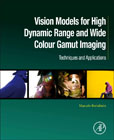
Tone and Gamut Mapping for High Dynamic Range and Colour Gamut Imaging: Vision Models, Techniques and Applications
Bertalmío, Marcelo
Tone and Gamut Mapping for High Dynamic Range and Colour Gamut Imaging: Vision Models, Techniques and Applications explains tone and color gamut mapping in HDR and WCG imaging within a framework of vision science, presenting the underlying principles and latest practical methods. In addition, it highlights how the use of vision models is a key element of all state-of- the-art methods for these emerging technologies. This book provides university researchers and graduate students in computer science, computer engineering, vision science, and R&D engineers insights into the science and methods of tone and color gamut mapping in HDR and WCG. Presents vision science principles and models that are essential to the emerging technologies of HDR and WCGProvides state-of-the-art techniques for tone and gamut mappingCovers current and proposed standards, open challenges and future directions of HDR and WCG research INDICE: Part 1: Vision Science overview 1. The biology of vision: retina, LGN, visual cortex, receptive fields, visual pathways, organization and feedback 2. Natural image statistics and efficient representation 3. Models for the perception of lightness, brightness, contrast and color 4. Open problems: limitations of the models, natural vs. artificial stimuli, viewing conditions, image quality assessment, individual differences. Part II. Vision models for direct and inverse tone mapping in HDR imaging 5. Dynamic range of cameras and displays: the need for tone mapping, literature overview 6. System gamma, display characteristics, viewing conditions: effect on image appearance 7. Detail visibility and encoding: the standards PQ and HLG 8. State of the art: tone mapping methods based on vision models 9. Evaluation. Tone mapping metrics vs psychophysical tests. Limitations of objective metrics 10. Inverse tone mapping 11. Open problems, future directions: vision model limitations, dynamic range and spatiotemporal artifacts, guidelines for production and post-production of HDR content. Part III. Vision models for color gamut mapping in WCG imaging. 12. Color gamut of cameras and displays: the need for gamut mapping, literature overview 13. Display characteristics, viewing conditions: effect on image appearance 14. State of the art: gamut mapping methods based on vision models 15. Evaluation. Gamut mapping metrics vs psychophysical tests. Limitations of objective metrics 16. Open problems, future directions: vision model limitations, wide gamut and individual differences, guidelines for production and post-production of WCG content.
- ISBN: 978-0-12-813894-6
- Editorial: Academic Press
- Encuadernacion: Rústica
- Páginas: 325
- Fecha Publicación: 01/10/2019
- Nº Volúmenes: 1
- Idioma: Inglés
